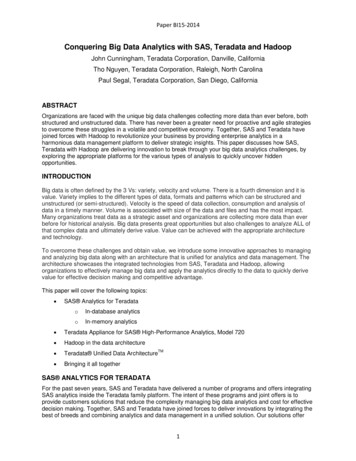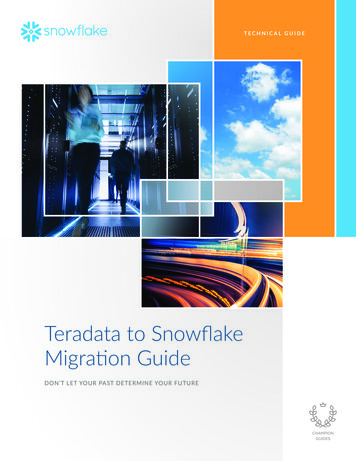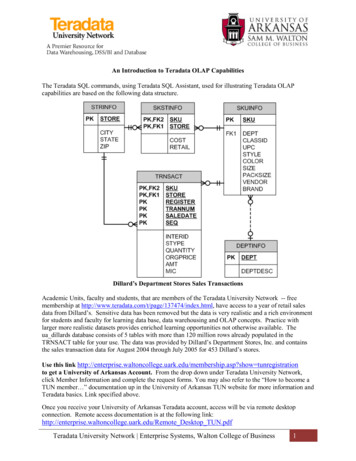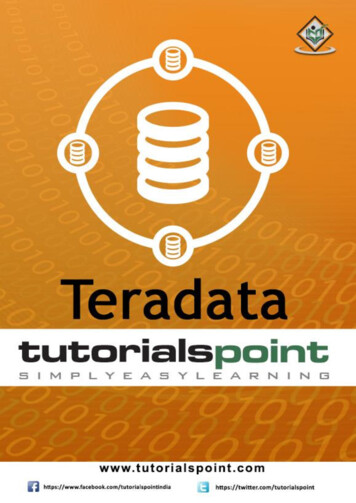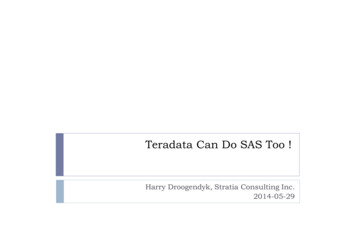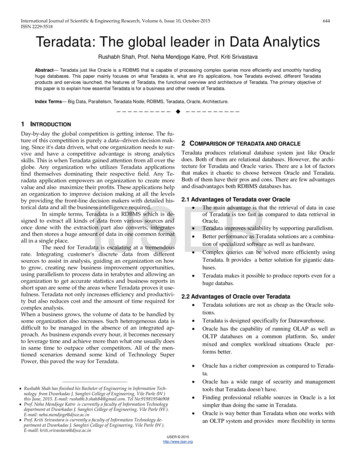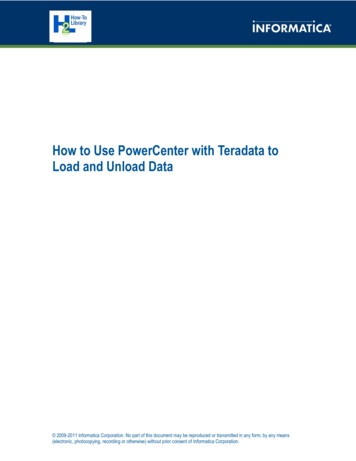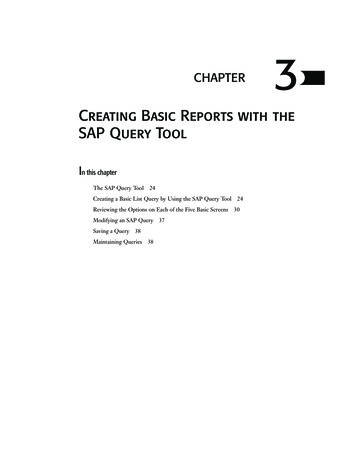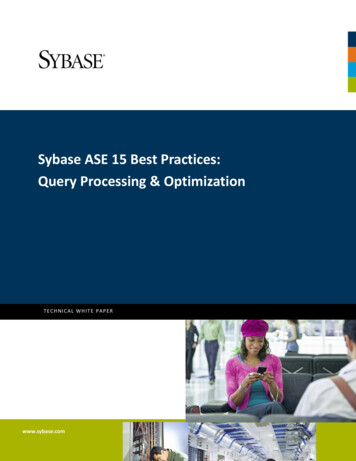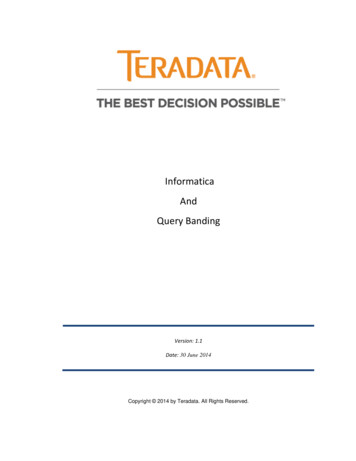
Transcription
InformaticaAndQuery BandingVersion: 1.1Date: 30 June 2014Copyright 2014 by Teradata. All Rights Reserved.
Table of ContentsTable of ContentsOverview . 3What is Query Banding? . 4Tag queries .5Determine usage needs .5Banding .5Landing .6Informatica and Query Banding . 8TPT API Connections.9ODBC Connections .11Appendix . 13Informatica Pre-Defined Parameters .13
Informatica and Query BandingOverviewThe primary purpose of this document is to provide information on how to implement ‘query banding’in informatica.For a complete overview of the Query Band feature, please see Teradata User Documentation as well asexisting Orange Books on this topic. This document will only discuss the opportunities to implementQuery Bands within an Informatica environment.Page 3
Informatica and Query BandingWhat is Query Banding?Scientists will often band the legs of birds with devices to track their flight paths. Monitoring and analyzing thedata retrieved via the bands provides critical information about the species.The same process holds true for DBAs who need more information about a query than what is typicallyavailable. Metadata—such as the name of the requesting user, the work unit and the application name—isimportant for, among other purposes, workload management, tracking the use of the data warehouse and querytroubleshooting.The sort of details provided through metadata can be linked to the query using the query banding feature in theTeradata Database. A query band contains any number of name/value pairs that use reserved or custom defined names to set, for instance, the initiating user’s corporate ID, department name and location, the nameand version of the application, and the time the initiating thread of execution started. These query identifiers canbe included in workload management rules and in applications and then captured in the Database Query Log(DBQL), where they are used to analyze the work flowing through the system (See figure 1).Page 4
Informatica and Query BandingTag queriesQuery banding is especially valuable when applications use connection pools to send queries to the database.Because each query session in a connection pool is tied to the database with the same user ID, all standardmetadata is identical. Adding a query band that stores the detailed metadata enables various departments andunits to identify the unique attributes of each request. For instance, DBAs can track the user or application ofeach request for chargeback purposes and associate users with requests for security measures.Teradata Dynamic Workload Management also uses query banding to identify on a more specific level thequeries that should receive a higher or lower priority. Concurrency levels are adjusted by assigning differentworkload rules. System administrators use query banding for troubleshooting to identify queries that are runningtoo long or those that have created a system backlog. The information typically available in queries does notoffer this sort of refinement.Determine usage needsBefore query banding can be applied, users must first strategize how it will be employed, then design the queryband names and values. Query bands may be set with the specific values (indicated in parentheses) and usedto: Identify the origin of application requests made via connection pools (Client User, Group, ApplicationName, Source and Action) Associate all requests in a job (JobID, JobLen and JobSeq) Adjust the priority of a job (Importance level)The standard set of query band names is defined for use by Teradata enterprise applications, as well as by theapplications of customers and partners. (See table.) The list of reserved and optional query band names willprovide additional consistency.Examples of query band name/value pairs are:– ApplicationName InventoryApp;– Version 01.00.00.00;– ClientUser dg120444;– JobID 998;BandingThe query band is set by using the “SET QUERY BAND” SQL statement:SET QUERY BAND ‘ApplicationName InventoryApp; Version 01.00.00.00;’ FORSESSION;The session query band is stored in the session table and applied to each request. It remains set for theduration of the session or until the query band is replaced by another. In case of a system reset, the query bandis recovered.A query band can also be applied to all of the requests within a transaction. When the application requests aconnection from the pool to perform a service for a client user—for instance, saving data to the database—itsets the transaction query band with attributes specific to that service request, as follows:Page 5
Informatica and Query BandingSET QUERY BAND ‘ClientUser dg120444; Group Sales; JobID 998;’ FORTRANSACTION;When the transaction completes, the transaction query band is automatically discarded. Therefore, no cleanupis required before reusing the connection for another service request.LandingDBQL is used to record query processing activity. When Query Logging is enabled, the query band for eachrequest is written to the DBQlogTbl table.For chargeback, accounting and other types of system management, administrators find it useful to have theadditional data that is provided with the query band, such as corporate user ID, department and report name.If an application has set the query band with ClientUser name, for example, users can extract resource us agereports from DBQL based on this information:SEL SUM(AMPCPUTIME), SUM(t1.ParserCPUTime)from dbc.qrylog t1 wheret1.QueryBand is NOT NULL AND GetQueryBandValue(t1.queryband, 0,Page 6
Informatica and Query Banding‘ClientUser’) ‘MW DCollins’;SUM(AMPCPUTime) SUM(ParserCPUTime)-------------- ------------------0.0160.062Page 7
Informatica and Query BandingInformatica and Query BandingCurrently, QB implementation can be implemented in the following Informatica Connections:A) TPTAPI (i.e., Power Exchange for Teradata Parallel Transporter API)B) Relational (i.e., use of ODBC DSN from a Relational Connection)Currently, use of Query Bands within a stand-Alone Utilities Job (FastLoad, MultiLoad, TPump, andFastExport) is not supported.Note the syntactical differences between inputting Query Band name-value pair between TPTAPI andnon-TPTAPI scenarios. TPTAPI QB input field requires only the name-value pairs separated by a semicolon (;).The Relational-Teradata-ODBC input field requires the standard SET QUERY BAND ‘a 1; ‘ FORSESSION; syntax.Many Built-in variables can be utilized for dynamic value portion of the Query Band. Refer toTransformation Language Reference documentation for updated list. See the example forRelational/ODBC for details.Page 8
Informatica and Query BandingTPT API ConnectionsMinimum Requirements: Power Exchange for Teradata Parallel Transporter 8.6.1.0.3The query band can be set in the informatica session where a Teradata Parallel Transport Reader orWriter is used.The attribute ‘Query Band’ can be set with name-value pairs, with each name-value pair terminatedwith a semi-colon.The internal informatica pre-defined parameters can be used. Those are then ‘parsed’ and set in thequery band during initialization. (see appendix for a list of parameters and what they do).The query band string can be set from a parameter whom’s value resides in the parameter file.See example below:If the parameter was set to bePage 9
Informatica and Query Banding Param TPT Query Band APP Infa;UserName PMRepositoryUserName;StartTime SessStartTime;The output in the DBQL table would beDBQL result: S APP Infa;UserName Administrator;StartTime 03/12/2012 11:38:44;Sample: Param TPT Query Band APP INFA;LOADER TPT;PMFolderName PMFolderName;PMWorkflowRunId PMWorkflowRunId;PMWorkflowName PMWorkflowName;PMSessionName PMSessionName;PMMappingName PMMappingName;PMRepositoryUserName PMRepositoryUserName;StartTime SessStartTime; Table Name Param Target Table Name;Page 10
Informatica and Query BandingODBC ConnectionsThe Query Band can be set in the ‘Connection’ section of the odbc connection. Every time thisconnection is used, the query band will be set.Best practice is to use the internal informatica pre-defined parameters that provide information aboutwhat workflow, session, mapping, user etc is been used.The syntax for the connection string is :SET QUERY BAND ‘App InventoryApp; UserName PMRepositoryUserName;StartTime SessStartTime;’ FORSESSION;Ie ODBC Connection informationPage 11
Informatica and Query BandingIe Connection Attribute:The output in the DBQL table would beDBQL result: S APP INFA;PMFolderName SAMPLES CORE;PMWorkflowRunId 2839;PMWorkflowName wf STORE STG TO STORE CORE;PMSessionName s m STORE INS;PMMappingName m STORE INS;PMRepositoryUserName Administrator;PMIntegrationServiceName DICOEis USA;PMSessionRunMode Normal;PMWorkflowRunInstanceName ;PMRepositoryServiceName DICOErepUSA;SampleSET QUERY BAND 'APP INFA;PMFolderName PMFolderName;PMWorkflowRunId PMWorkflowRunId;PMWorkflowName PMWorkflowName;PMSessionName PMSessionName;PMMappingName PMMappingName;PMRepositoryUserName PMRepositoryUserName;PMIntegrationServiceName PMIntegrationServiceName;PMSessionRunMode PMSessionRunMode;PMWorkflowRunInstanceName PMWorkflowRunInstanceName;PMRepositoryServiceName PMRepositoryServiceName;StartTime SessStartTime;'FOR SESSION;Page 12
Informatica and Query BandingAppendixInformatica Pre-Defined ParametersInformatica Pre-defined Parameters are as follows:Parameter NameDescription PMFolderNameReturns the folder name. PMWorkflowNameReturns the workflow name. PMWorkflowRunIdReturns the workflow run ID. PMWorkflowRunInstanceNameReturns the workflow run instance name. PMIntegrationServiceNameReturns the Integration Service name. PMMappingNameReturns the mapping name. PMRepositoryServiceNameReturns the Repository Service name. PMRepositoryUserNameReturns the repository user name. PMSessionNameReturns the session name. PMSessionRunModeReturns the session run mode (normal or recovery). PMSourceName@TableNameReturns the table name for the named source instance. PMTargetName@TableNameReturns the table name for the named target instance. SessStartTimeReturns the date time the session executesPage 13
Informatica and Query Banding Overview The primary purpose of this document is to provide information on how to implement ‘query banding’ in informatica. For a complete overview of the Query Band feature, please see Teradata User Documentation as well as existing Orange Books on this topic. This document will only discuss the opportunities to implement

